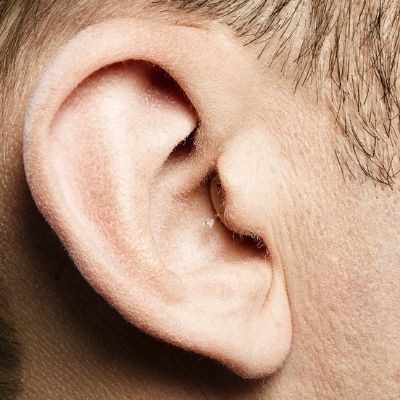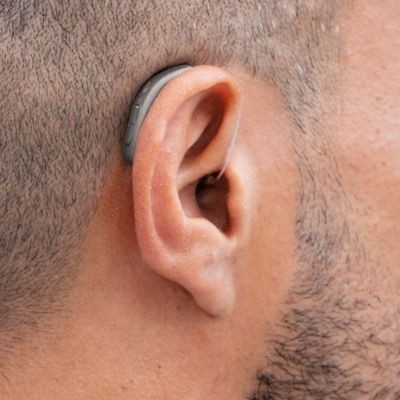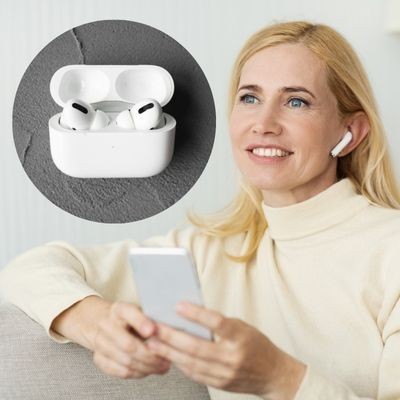
Head of Online Medical Content

Audiology Expert at Hearing Aid UK

In-the-Ear (ITE) vs Over-the-Ear (OTE) Hearing Aids
The Pros and Cons of Both
Overview | ITE hearing aids | Pros of ITE hearing aids | Cons of ITE hearing aids | OTE hearing aids | Pros of OTE hearing aids | Cons of OTE hearing aids | Conclusion
Compliment your hearing needs - Which hearing aid style is best for me?
A journey to find the best hearing aid that will compliment your unique hearing loss. Whichever you choose, it is important to remember that the main result should be to gain optimum clarity and regain as much of your natural hearing as possible.
The fundamental design of any hearing aid is to amplify your surroundings with features, technology, and settings to erase background noise and feedback. This way you can access a better sound in conversation, music, and in challenging hearing situations.
Selection of types, shapes, and features
With a plethora of styles to choose from, it’s hard to know where to start in the process and with variances in amplification, price, style, and size, it’s no wonder. But the main hurdle is to decide whether you want over-the-ear or In the Ear hearing aids.
This is ultimately determined by your hearing loss, ear shape, the severity of the loss, the connectivity you require, and lifestyle. Here we give a quick breakdown of the advantages and disadvantages of both – which we hope will give transparency that helps to steer you in the right direction.
In-the-Ear (ITE) hearing aids overview
ITE hearing aids, broadly speaking, are commonly custom-made for your unique ear, so that they sit comfortably and easily inside your ear, rather than outside it. However, you can opt for a generic shell that is designed to fit all ears. This option is, therefore, a cheaper alternative – as with anything bespoke you pay a little bit more so that it is a tailored fit.
This style of hearing aid is compatible with those who have a hearing loss of mild to severe. We have used the term ‘ITE’ to simplify and differentiate hearing aids that sit within your ear and those that sit outside.
There are a few options in this style, these being:
- In-the-Canal (ITC): These are designed to fit just into the entrance of the ear canal and are also known as a Half Shell hearing aid.
- Completely-in-the-Canal (CIC): This type of hearing aid fits neatly into your ear canal, meaning that it is very inconspicuous and discreet.
- In-the-Ear (ITE): Also known as a Full Shell and designed as a single unit that fills the outer ear.
- Invisible-in-the-Canal (IIC): These hearing aids are just as their name suggests and are almost completely invisible when worn, as they sit deeper in the ear canal.

ITE vs BTE Hearing Aids Comparison
ITE Hearing Aid Reviews
Generic advantages of In-the-Ear (ITE) hearing aids:
- Generally, this type of hearing aid is very small, discreet, and comfortable to wear.
- They tend to be easy to insert for most people, but it is important to note that those with limited dexterity may struggle.
- ITE models are less likely to pick up wind noise, as they sit inside the ear and are not as exposed as hearing aids outside the ear.
Generic disadvantages of In-the-Ear (ITE) hearing aids:
- They are more expensive because they are generally tailor-made to your ear shape and size.
- Because they are small, they are not as technologically powerful, and features and settings are limited. However, there are some impressive models in the industry.
- Because this type of hearing aid sits inside the ear, it needs to be cleaned more regularly, due to earwax buildup.
- A small hearing aid means small batteries, and sometimes these can be quite difficult to change. So, if dexterity is a problem, then these hearing aids might not be right for you.
Over-the-Ear (OTE) hearing aids overview
This style of hearing aid includes the Behind-the-Ear (BTE), also known as an open-fit aid, and Receiver-in-the-Canal (RIC) hearing aids. They are both worn behind the ear, but the BTE model has an ear mould that sits inside the ear canal.
The RIC hearing aid has a receiver that is worn within the ear canal, which is attached to a wire that is worn over the ear. A more slim and tidier version of BTE, so to speak.

BTE vs ITE Hearing Aids Comparison
OTE Hearing Aid Reviews
Generic advantages of Behind-the-Ear (BTE) and Receiver-in-the-Canal (RIC) hearing aids:
- These hearing aids seem to be a good choice for all age groups and a large range of hearing loss levels.
- These models provide a greater listening experience regarding amplification.
- They use larger batteries, so they last significantly longer, or they don’t need to be charged as regularly.
- They are generally cheaper than ITE hearing aids and offer a great choice of styles, technology, and colours.
Generic disadvantages of Behind-the-Ear (BTE) and Receiver-in-the-Canal (RIC) hearing aids:
- They aren’t as discreet as ITE models, but there are now mini BTE (or RITE hearing aids) for a smaller alternative that doesn’t compromise on price or technology specifications.
- Because of the BTE hearing aid microphone placement, you are more than likely going to experience wind noise. However, most models do have wind noise cancellation settings within their technology features to assist with this.
- The RIC hearing aids are known to get blocked with excessive earwax and need to be cleaned regularly, which may lead to repairs if not managed properly.
Why Choose Us?
- FREE Hearing Tests
- Best Hearing Aids and Prices
- FREE Aftercare for Life
- FREE Home Visits
- 200+ Local Audiologists
- 60 Day Money Back Guarantee
ITE vs BTE Hearing Aids Comparison
Although we have given a basic rundown on the general advantages and disadvantages of both styles – it is truly down to a balance of your lifestyle and hearing loss needs.
When you have your hearing test, your audiologist will go through your audiogram results and define your hearing solution needs.
Only then will they be able to recommend hearing aids that will give you a premium hearing solution that is right for you. If you would like to speak to an audiologist about the ITE hearing aids or BTE hearing aids available to you locally, call us free on 0800 567 7621
Hearing aid advice articles you might like...
 Do Hearing Aids Work for Everyone?
Do Hearing Aids Work for Everyone?  Wearing Hearing Aids with Glasses
Wearing Hearing Aids with Glasses  Risks of Wearing Apple AirPod Pro 2's
Risks of Wearing Apple AirPod Pro 2's What's included in our hearing aid prices?
Watch our BTE vs ITE hearing aid video below
Common FAQs about hearing aids and hearing loss
If you are looking at this page then it is likely that an audiologist has suggested that you purchase this particular hearing aid, so is this the best model for you?
In general, any audiologist will always recommend to you the model that best suits your needs. Here is a useful checklist to make sure that is the case.
- Audiologist level of knowledge: The audiologist you have seen will hopefully have a wide knowledge of all available hearing aids, however, some will only be familiar with a small number of brands and therefore may not really be in a position to know which model is the best for you. It is OK to challenge their recommendation and ask them to justify why this particular brand is the one for you.
- Do research: Read about the hearing aid that was recommended. Does it seem like it will suit your lifestyle? Does it have more or fewer features than you need?
- Be aware of sales targets: Many high street retailers have specific tie-ins to a particular manufacturer/brand. The hearing aid they have suggested may still be the correct one for you, but do your research so that you know why they might have recommended it.
If in doubt, feel free to give us a call. That's what we're here for. In the meantime, read all about our review of the best hearing aids for 2025 here
If you have significant hearing loss in both ears, you should be wearing two hearing aids. Here are the audiological reasons why:
Localisation: The brain decodes information from both ears and compares and contrasts them. By analysing the minuscule time delays as well as the difference in the loudness of each sound reaching the ears, the person is able to accurately locate a sound source. Simply put, if you have better hearing on one side than the other, you can't accurately tell what direction sounds are coming from.
Less amplification is required: A phenomenon known as “binaural summation” means that the hearing aids can be set at a lower and more natural volume setting than if you wore only one hearing aid.
Head shadow effect: High frequencies, the part of your hearing that gives clarity and meaning to speech sounds, cannot bend around your head. Only low frequencies can. Therefore if someone is talking on your unaided side you are likely to hear that they are speaking, but be unable to tell what they have said.
Noise reduction: The brain has its own built-in noise reduction which is only really effective when it is receiving information from both ears. If only one ear is aided, even with the best hearing aid in the world, it will be difficult for you to hear in background noise as your brain is trying to retain all of the sounds (including background noise) rather than filtering it out.
Sound quality: We are designed to hear in stereo. Only hearing from one side sounds a lot less natural to us.
Fancy some further reading on this topic? You can read about why two hearing aids are better than one in our article, hearing aids for both ears, here
For most people, the main benefit of a rechargeable hearing aid is simple convenience. We are used to plugging in our phones and other devices overnight for them to charge up. Here are some other pros and cons:
For anybody with poor dexterity or issues with their fingers, having a rechargeable aid makes a huge difference as normal hearing aid batteries are quite small and some people find them fiddly to change.
One downside is that if you forget to charge your hearing aid, then it is a problem that can't be instantly fixed. For most a 30-minute charge will get you at least two or three hours of hearing, but if you are the type of person who is likely to forget to plug them in regularly then you're probably better off with standard batteries.
Rechargeable aids are also a little bit bigger and are only available in Behind the Ear models.
Finally, just like with a mobile phone, the amount of charge you get on day one is not going to be the same as you get a few years down the line. Be sure to ask what the policy is with the manufacturer warranty when it comes to replacing the battery.
Looking for more information on rechargeable hearing aids? Read our dedicated page on the topic here
For most people, the answer is yes. But it's never that simple.
The majority of hearing problems affect the high frequencies a lot more than the low ones. Therefore open fitting hearing aids sound a lot more natural and ones that block your ears up can make your own voice sound like you are talking with your head in a bucket. Therefore in-ear aids tend to be less natural.
However the true answer is we can't tell until we have had a look in your ears to assess the size of your ear canal, and until we have tested your hearing to see which frequencies are being affected.
People with wider ear canals tend to have more flexibility, also there are open fitting modular CIC hearing aids now that do not block your ears.
There is also the age old rule to consider, that a hearing aid will not help you if it's sat in the drawer gathering dust. If the only hearing aid you would be happy wearing is one that people can't see, then that's what you should get.
Most people can adapt to any type of hearing aid, as long as they know what to expect. Have an honest conversation with your audiologist as to what your needs are.
Generally speaking, six or more. Unless it's none at all.
The number of channels a hearing aid has is often a simplistic way an audiologist will use to explain why one hearing aid is better than another, but channels are complex and it is really not that straightforward. Here are some reasons why:
Hearing aids amplify sounds of different frequencies by different amounts. Most people have lost more high frequencies than low and therefore need more amplification in the high frequencies. The range of sounds you hear are split into frequency bands or channels and the hearing aids are set to provide the right amount of hearing at each frequency level.
Less than six channels and this cannot be done with much accuracy, so six is the magic number. However, a six channel aid is typically very basic with few other features and is suitable only for hearing a single speaker in a quiet room. The number of channels is not what you should be looking at, it's more the rest of the technology that comes with them.
As a final note, different manufacturers have different approaches. One method is not necessarily better than any other. For example, some manufacturers have as many as 64 channels in their top aids. Most tend to have between 17 and 20. One manufacturer has no channels at all.
Hearing aids are easily lost, misplaced or damaged and typically are one of the most expensive personal possessions an individual can own. We offer hearing aid warranty coverage for £80 per year per aid. Find out more about this service we provide here
All our audiologists use the very latest technology and provide the full range of tests to accurately measure your hearing for free. Find out about what hearing healthcare services we offer all our customers here
Hearing Aid UK offers all their customers free home visiting services, even in a care home environment, for no extra cost. Including hearing tests, fittings, maintenance, check-ups and much more in the comfort of your own home and at your convenience. Find out more information about our home visits here
Here, at Hearing Aid UK, we are dedicated to offering low hearing aid prices. We achieve this by having no head office and low marketing costs. Our hearing aid prices are amongst the lowest you will find anywhere in the world. Explore our prices, brands, and models here
Other pages you might find useful
Ask the Experts
6 Morton Lane
Walkwood
Redditch
Worcestershire
B97 5QA
Latest Launch
When we refer to a product as 'Latest Launch', we mean it is the latest to be released on the market.
New
When we refer to a product as 'New', we mean that the product is the newest hearing aid model on the market.
When we refer to a product as 'Superseded', we mean that there is a newer range available which replaces and improves on this product.
Older Model
When we refer to a product as an 'Older Model', we mean that it is has been superseded by at least two more recent hearing aid ranges.
